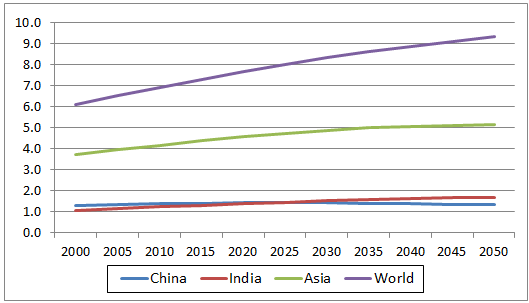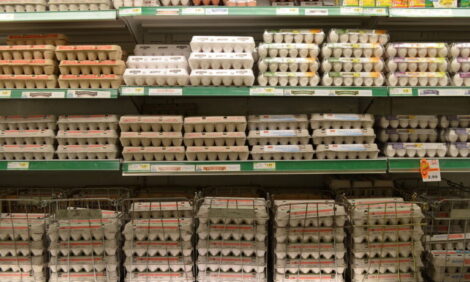



GLOBAL POULTRY TRENDS 2012 - India’s Population to Exceed China’s by 2022
As a region, human population in Asia will rise more slowly than the global average, writes Terry Evans, but social and economic changes mean that chicken meat consumption will continue to develop in most countries, both overall and per person.Asia’s human population is forecast to grow at a slower rate than the global total. Thus, between 2000 and 2050, while the world population will likely expand by some 52 per cent to exceed 9.3 billion, the number of people in Asia is forecast to increase by 38 per cent to around 5.15 billion. So by 2050, Asia will account for 55 per cent of the global total compared with 61 per cent in 2000.
However, within Asia, India’s rate of growth will easily outstrip that for China. Thus, between 2000 and 2050 India’s population will rise by 61 per cent, while the total in China is expected to increase up to 2030 but then decline, such that by 2050, the human population for China will be only 2.3 per cent higher than 30 years earlier. By 2022, India’s population, at just over 1.43 billion, will have overtaken China (Figure 1).

Food consumption in Asia is increasingly driven by a shift in uptake towards more livestock products. Meat consumption has been growing at more than four per cent a year. According to the FAO, the rapid growth in the meat sector has been underpinned by a rising demand for poultry meat, which has consistently increased at around three times the rate of population growth over each of the past five decades.
The increase in the demand for animal protein is, to a considerable extent, boosted by strong gross domestic product (GDP) growth and urbanisation. In broad terms, every one per cent increase in GDP will result in a one per cent increase in poultry uptake. At the household level, not surprisingly, the rich people eat more chicken than the poor and they tend to have a preference for further-processed added-value items. Price and income changes tend to have little impact on the purchasing habits of the well-off. The opposite is true at the other end of the income scale, with the quantities of basic chicken products bought being highly susceptible to both income and price changes.
Over half of the world’s population now resides in towns or cities. This impacts on food purchases as urban dwellers tend to have higher disposable incomes and also a greater choice of foods than those living in the country. Nevertheless, in developed economies, regardless of income status, the purchasing habits of almost everyone change in times of recession with the majority of consumers trading down to less expensive products.
For Asia, the outlook is for continued growth in the demand for meat, in particular, poultry meat.
While quite often data presented on the poultry industry needs to be taken with ‘a pinch or grain of salt’, when it comes to figures on the levels of consumption per person per year, then it is not unreasonable to say that some of these may need to be taken with ‘a handful of salt’. Hence, the consumption figures – expressed to the nearest whole number – shown in Table 1, need to be treated with caution. It appears that poultry uptake in Asia as a whole has grown by some 25 per cent between 2007 and 2012 from 8kg to 10kg per person. At the same time, estimated global uptake has risen by some 15 per cent from 13kg to 15kg per person per year.
Regarding individual countries, in nearly every case where comparisons are possible, average consumption has risen. However, this table also highlights the extremely wide range in uptake from as little as one to two kilos per person to more than 60kg, although admittedly the latter are exceptional.
Estimates of consumption in China do not include chicken paws. Despite the increase in feed costs, more efficient feed conversion has helped chicken meat maintain its competitive position over red meat. However, while chicken is considered a substitute for red meats when the latter are in short supply, the key factor in chicken uptake is the price of pork, which accounts for more than half of Chinese meat consumption.
Expansion in the middle class in India is helping to boost the demand for more plentiful and less costly proteins and consequently chicken meat. This is underlined by the estimates in Table 1, which point to a 50 per cent increase in average uptake over five years, Because of its huge population of 1.3 billion, even a small rise in average uptake will translate into a large increase in the total volume of chicken eaten. Other factors favouring chicken consumption according to a recent USDA GAIN report are: increasing employment levels and incomes; a growing demand for ready-to-eat products; a rise in the number of quick-service establishments and a general preference for poultry over other meats on a price basis and in some instances cultural and religious reasons. Although total chicken consumption is forecast to double by 2014/15, the quantity eaten per person is unlikely to reflect this because of the continued expansion of the human population.
About 50 per cent of population of Iran is under 25 years of age with the ratio of the urban sector to villagers being 67:33. A doubling of output between 2000 and 2010 has meant that chicken has changed from being considered a luxury food to a product frequently found on everyone’s table. This not only reflects the price-competitive position of chicken versus red meat but also increasing concerns over the level of cholesterol in people’s diets.
Slow economic growth has led many consumers in Japan to opt for low-priced protein sources and this has helped sustain the levels of chicken consumption. Outbreaks of HPAI early in 2011 and the earthquake that devastated the Tohoku and Kanto regions impacted adversely on the broiler market though a recovery is now underway. According to the latest USDA GAIN report, broilers account for 90 per cent of the poultry market with boneless leg meat generally being preferred to breast meat. In the past, breast meat has mainly been utilised for prepared foods and processing but recently, it has proved more popular at the retail level appealing to those shoppers looking for low-priced items.
After the earthquake, consumers temporarily refrained from eating out. Although this boosted household uptake, perishable foods including fresh meat and chicken tended to be avoided with buyers preferring to purchase ready-to-eat meals and convenience items.
Chicken consumption in Turkey has risen sharply to around 21kg per person per year, while the industry has a target of 30kg for the near future.
In Thailand, high pork prices as well as increases in the quick-service restaurant sector and ready-to-eat outlets have benefited domestic chicken uptake. Here, as in other Asian countries, consumers prefer dark to white chicken meat.
July 2012









